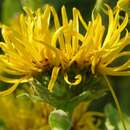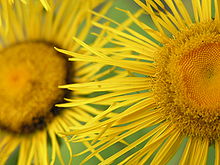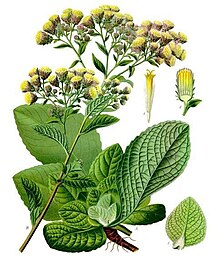en
names in breadcrumbs


Inula is a genus of about 80 species of flowering plants in the family Asteraceae, native to Europe, Asia and Africa.
They may be annuals, herbaceous perennials or subshrubs that vary greatly in size, from small species a few centimeters tall to enormous perennials over 3 m (10 ft) tall. They carry yellow daisy-like composite flowerheads often with narrow ray-florets.
Some common characteristics include pappus with bristles, flat capitulum, and lack of chaff.
Several species are popular flowers for the garden, with cultivation going back to antiquity. The smaller species are used in rock gardens and the more common larger ones, which tend to have very coarse foliage, in borders.
The genus name Inula is of uncertain origin, and was already in use by the Romans. The Latin phrase inula campana (field inula) gave rise to the English elecampane whose scientific name is Inula helenium. The plant's specific name, helenium, derives from Helen of Troy; elecampane is said to have sprung up from where her tears fell.[3]
The following species are recognised in the genus Inula:[4]
Inula species are used as food plants by the larvae of some Lepidoptera species including case-bearers of the genus Coleophora, such as C. conyzae (recorded on I. conyzae), C. follicularis, C. inulae, and C. troglodytella.
 Inula helenium
Inula helenium  Inula oculus-christi
Inula oculus-christi  Ploughman's-spikenard (Inula conyzae)
Ploughman's-spikenard (Inula conyzae) Inula is a genus of about 80 species of flowering plants in the family Asteraceae, native to Europe, Asia and Africa.
They may be annuals, herbaceous perennials or subshrubs that vary greatly in size, from small species a few centimeters tall to enormous perennials over 3 m (10 ft) tall. They carry yellow daisy-like composite flowerheads often with narrow ray-florets.
Some common characteristics include pappus with bristles, flat capitulum, and lack of chaff.
Several species are popular flowers for the garden, with cultivation going back to antiquity. The smaller species are used in rock gardens and the more common larger ones, which tend to have very coarse foliage, in borders.